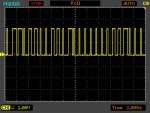Hi,
I purchased a WWVB module (http://www.pvelectronics.co.uk/index.php?main_page=product_info&cPath=9&products_id=7) to experiment with the NIST time signal sent out from the WWVB transmitter near Fort Collins Colorado. I have a La Crosse analog clock that receives its time from that transmitter, so although I live in Canada, I know I can receive the signal.
I hooked up the module and had to wait until about 8pm (local time) here, but I started to get the signal as evidenced from the onboard LED. I also hooked it up to my scope and was able to see a nice clean signal that exactly followed the format given by the WWVB website (http://tf.nist.gov/stations/wwvbtimecode.htm). With a little practice, I was able to decode the pulses as seen on my scope, by eye, and convert the bits to read out the information (to prove to myself that I was getting valid data).
So, next step was to try and get a Picaxe chip to read/convert the data. I figured that since the format diagram shows that at the top of the minute there are two 800 ms pulses separated by a 200 ms gap, I could have the Picaxe watch the incomming pulses using PULSIN until it saw that combination (Two 800 ms pulses in a row). That's when my idea fell apart as I soon figured out that at the lowest possible frequency (4 MHz) the PULSIN value of 10 us means I can only read a pulse of up to 655.36 ms....
So, is there a way I can check reliably for a 800 ms pulse ?
I see from my searches that people have gotten the decoding the NPL MSF time signal, but it appears to use a maximum pulse width of 500 ms which can be handled by PULSIN.
Has anyone been able to use a Picaxe to decode the US WWVB signal ??
Thanks, John.
I purchased a WWVB module (http://www.pvelectronics.co.uk/index.php?main_page=product_info&cPath=9&products_id=7) to experiment with the NIST time signal sent out from the WWVB transmitter near Fort Collins Colorado. I have a La Crosse analog clock that receives its time from that transmitter, so although I live in Canada, I know I can receive the signal.
I hooked up the module and had to wait until about 8pm (local time) here, but I started to get the signal as evidenced from the onboard LED. I also hooked it up to my scope and was able to see a nice clean signal that exactly followed the format given by the WWVB website (http://tf.nist.gov/stations/wwvbtimecode.htm). With a little practice, I was able to decode the pulses as seen on my scope, by eye, and convert the bits to read out the information (to prove to myself that I was getting valid data).
So, next step was to try and get a Picaxe chip to read/convert the data. I figured that since the format diagram shows that at the top of the minute there are two 800 ms pulses separated by a 200 ms gap, I could have the Picaxe watch the incomming pulses using PULSIN until it saw that combination (Two 800 ms pulses in a row). That's when my idea fell apart as I soon figured out that at the lowest possible frequency (4 MHz) the PULSIN value of 10 us means I can only read a pulse of up to 655.36 ms....
So, is there a way I can check reliably for a 800 ms pulse ?
I see from my searches that people have gotten the decoding the NPL MSF time signal, but it appears to use a maximum pulse width of 500 ms which can be handled by PULSIN.
Has anyone been able to use a Picaxe to decode the US WWVB signal ??
Thanks, John.


